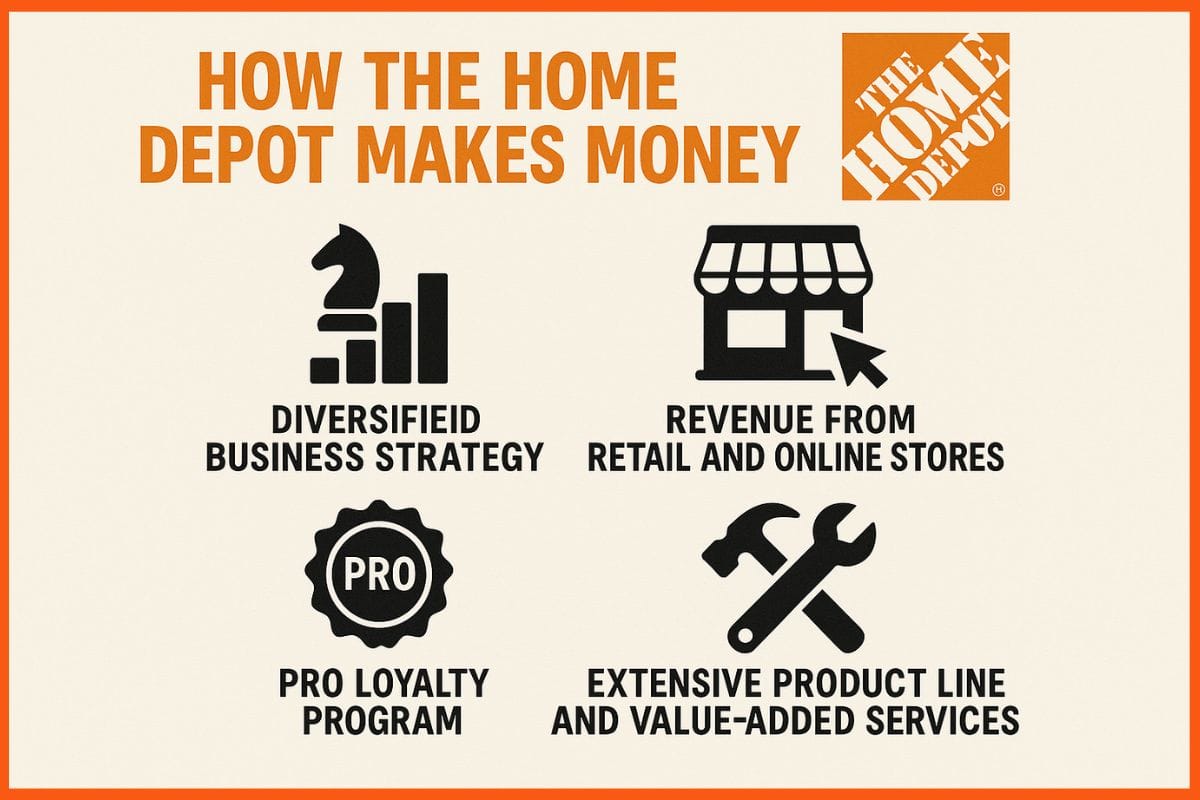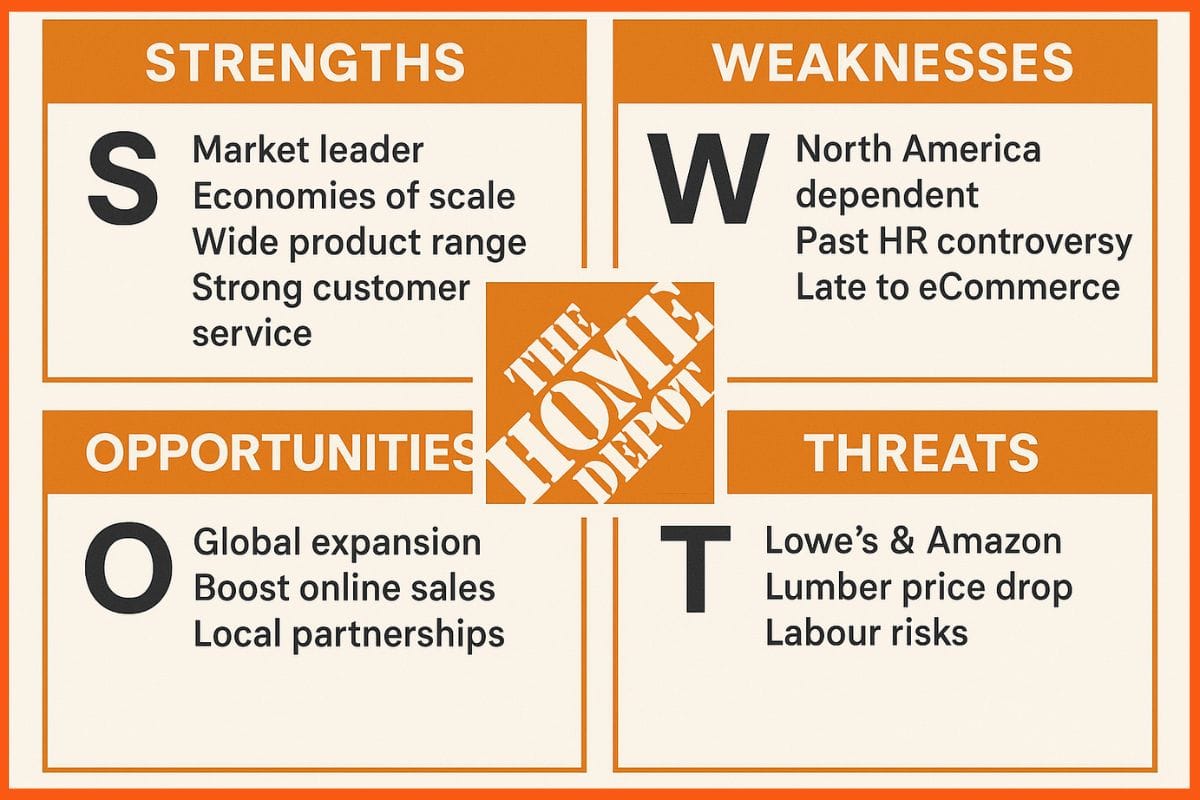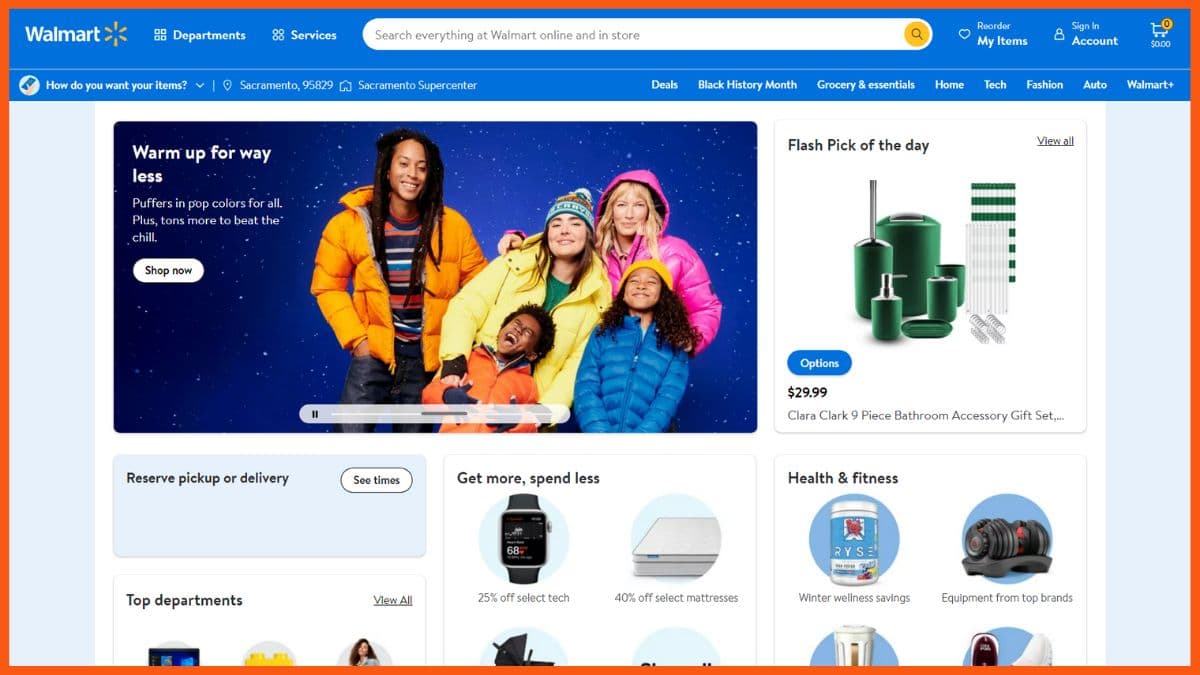The largest home improvement retailer in the world, The Home Depot is based in Cobb County, Georgia, at the Atlanta Store Support Centre. It provides a wide selection of tools, construction supplies, appliances, and services. The Home Depot is a reliable source for both professional contractors and DIY enthusiasts, with thousands of big-box stores in the United States, including all 50 states, the District of Columbia, Puerto Rico, the US Virgin Islands, and Guam, as well as in all ten provinces of Canada and Mexico.
About The Home Depot
The Home Depot’s Business Model
How The Home Depot Makes Money?
USP of The Home Depot
SWOT Analysis of The Home Depot
About The Home Depot
Established in 1978, The Home Depot is a model of industry leadership, with its business model strongly rooted in the idea of offering a comprehensive one-stop shop for all home renovation needs. The company’s skill in implementing an omnichannel strategy is demonstrated by its ability to combine physical retail with a robust online presence. By providing in-store pickups, online purchases, and delivery services, this approach not only increases convenience but also improves the whole consumer experience.

The Home Depot’s Business Model
By combining physical retail with a strong online presence, The Home Depot’s business model is based on the idea of being a one-stop shop for all home renovation needs. This omnichannel strategy improves accessibility and convenience by enabling customers to buy products directly online, choose in-store pickup, or have items delivered to their homes. To set itself apart in the cutthroat industry, the business also provides installation services for a range of goods, such as water heaters, cabinets, and flooring. Additionally, in order to increase customer happiness and optimise operations, The Home Depot uses cutting-edge technology, including data analytics, integrated supply chains, and inventory optimisation.
How The Home Depot Makes Money?

The Home Depot has a diversified business strategy that includes the selling of a wide range of professional services and home improvement products.
- Generating Revenue Through Online as well as Retail Stores- The business benefits from both retail and online sales, with in-store transactions accounting for a sizable portion of revenue and its internet platform contributing more and more.
- Generating Revenue Through Pro Loyalty Programme- With its Pro Loyalty Program, which offers special discounts and incentives, The Home Depot supports repeat business by providing contractors and builders with professional-grade products and materials.
- Generating Revenue by Maintaining Large Product Line and Value Added Services- The Home Depot maintains a wide range of products, competitive pricing, and value-added services to guarantee a consistent and increasing income stream, thereby solidifying its dominant position in the retail home improvement sector.
USP of The Home Depot
The Home Depot’s skill in implementing an omnichannel strategy is demonstrated by its ability to combine physical retail with a robust online presence. By providing in-store pickups, online purchases, and delivery services, this approach not only increases convenience but also improves the whole consumer experience.
SWOT Analysis of The Home Depot

Strengths
- Being the biggest retailer of home improvement products, Home Depot gains more from economies of scale than its rivals.
- Home Depot has the largest selection in the retail home improvement industry. Customers may get all the distinctive home renovation supplies they need in one place, including tools, building materials, fixtures, fasteners, furnishings, and much more.
- Home Depot constantly aims to improve the shopping experience for its customers and has fostered a culture of excellence in customer service.
Weaknesses
- For The Home Depot, the Mexican market is uncertain, and both the US and Canada are maturing. Because of this, Home Depot’s overreliance on North America is a serious vulnerability.
- An employee at Home Depot was fired in 2018 for requesting an emergency break due to a handicap. The company’s reputation was damaged when it was compelled to pay $100K to resolve the dispute.
- eCommerce was implemented by The Home Depot later than the majority of its rivals. Consequently, a great deal of growth potential was lost by not implementing eCommerce sooner.
Opportunities
- Beyond North America, Home Depot ought to consider entering developing nations like China, India, and others that have countless chances for long-term, steady growth.
- The corporation has an advantage over rivals like Lowe’s because of its recent internet push. This indicates that if it boosts online sales, it has enormous development potential.
- The Home Depot has the opportunity to collaborate with local Chinese home improvement retailers in emerging markets who possess a comprehensive understanding of the marketplace, following its failure in China.
Threats
- The rate at which Lowe’s is catching up to Home Depot is concerning. Additionally, Home Depot’s market share is seriously threatened by Amazon.
- Since lumber makes up about 18% of Home Depot’s overall income, the price of lumber has decreased dramatically over the last two years, which has had a huge impact on the company.
- A significant operational risk to Home Depot’s success is labour disputes. Due to its vast workforce, the company is vulnerable to labour interruptions such as strikes.
Conclusion
Home Depot’s substantial market dominance, wide range of product options, and commitment to sustainability and customer service have all contributed to its status as a leader in the worldwide home improvement retail sector. The company’s strategic focus on e-commerce, global expansion, and improving the customer experience brings up significant potential opportunities despite challenges such as regional concentration, reliance on the housing market, and the need for digital transformation. Home Depot needs to use agility and strategic insight to overcome challenges, including intense competition, economic downturns, and changing consumer preferences, if it is to maintain its market leadership.

FAQs
What is The Home Depot known for?
The Home Depot is the world’s largest home improvement retailer, known for offering a wide selection of tools, construction materials, appliances, and services to both DIY homeowners and professional contractors.
Where is The Home Depot headquartered?
The Home Depot is headquartered in Cobb County, Georgia, at the Atlanta Store Support Centre.
How does The Home Depot make money?
The Home Depot generates revenue through both physical retail and online sales, professional installation services, and its Pro Loyalty Program, which caters to contractors and builders with exclusive deals and bulk pricing.
What is The Home Depot’s business model?
The Home Depot operates on an omnichannel retail model, combining in-store shopping, online orders, and delivery or pickup options. This one-stop shop strategy enhances convenience and the overall customer experience.





















